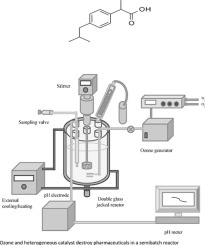Applied Catalysis B: Environment and Energy ( IF 20.2 ) Pub Date : 2018-02-21 , DOI: 10.1016/j.apcatb.2018.02.021 Soudabeh Saeid , Pasi Tolvanen , Narendra Kumar , Kari Eränen , Janne Peltonen , Markus Peurla , Jyri-Pekka Mikkola , Andreas Franz , Tapio Salmi

|
The Concern on the availability of clean and safe fresh water and the quality of recycled wastewater are important issues, which require a suitable technology to restore the water quality. Pharmaceuticals in waste water are not easily degraded by conventional water treatment technology. Advanced oxidation processes have been applied to eliminate traces of these compounds from aquatic environments. This study was focused on the degradation of ibuprofen (IBU) in aqueous solutions by catalytic and non-catalytic ozonation. Preliminary experiments were conducted to optimize the ozone concentration in water and to investigate other operation parameters. The operation parameters were: temperature, stirring rate, gas flow rate, pH, and use of Spinchem stirrer to reach higher concentrations of dissolved ozone. In general, the initial concentration of IBU was 10 mg/L, and about 93% of IBU was degraded after 4 h of ozonation under optimal conditions. Additional experiments were carried out to investigate the benefit of applying a solid catalyst. H-Beta and Fe-H-Beta type catalysts were immobilized in the Spinchem rotating bed device. The catalytic experiments illustrated a significant improvement in the degradation rate of IBU. The catalysts were characterized by nitrogen adsorption- desorption, scanning electron microscopy, transmission electron microscopy, X-ray powder diffraction and FTIR.
中文翻译:

用于从水溶液中去除布洛芬的先进氧化工艺:半间歇式反应器中的非催化臭氧氧化研究
对清洁和安全淡水的可用性以及回收废水的质量的关注是重要的问题,需要采用合适的技术来恢复水质。常规水处理技术不容易降解废水中的药物。已应用先进的氧化工艺从水生环境中消除痕量这些化合物。这项研究的重点是通过催化臭氧氧化和非催化臭氧氧化降解布洛芬(IBU)。进行了初步实验,以优化水中的臭氧浓度并研究其他操作参数。操作参数为:温度,搅拌速率,气体流速,pH值,以及使用Spinchem搅拌器达到更高浓度的溶解臭氧。一般来说,IBU的初始浓度为10 mg / L,在最佳条件下臭氧化4小时后,约93%的IBU降解。进行了另外的实验以研究使用固体催化剂的益处。H-Beta和Fe-H-Beta型催化剂固定在Spinchem旋转床装置中。催化实验表明,IBU的降解速率有显着提高。通过氮吸附-脱附,扫描电子显微镜,透射电子显微镜,X射线粉末衍射和FTIR对催化剂进行了表征。催化实验表明,IBU的降解速率有显着提高。通过氮吸附-脱附,扫描电子显微镜,透射电子显微镜,X射线粉末衍射和FTIR对催化剂进行了表征。催化实验表明,IBU的降解速率有显着提高。通过氮吸附-脱附,扫描电子显微镜,透射电子显微镜,X射线粉末衍射和FTIR对催化剂进行了表征。


















































 京公网安备 11010802027423号
京公网安备 11010802027423号